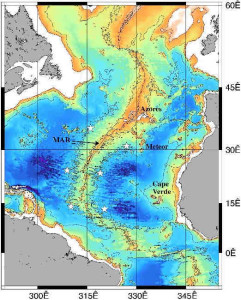HMS Challenger
Mid-Atlantic Ridge
 The Mid–Atlantic Ridge (MAR)(a) was first physically located in 1872 by Sir John Murray (1841-1914), the celebrated oceanographer while investigating a route for a transatlantic telegraph cable aboard HMS Challenger. John Thomas Short in The North Americans of Antiquity [1192.503] notes “that a member of the Challenger staff, in a lecture delivered in London soon after the termination of the expedition, expressed the fullest confidence thatof the great submarine plateau is the remains of the ‘Lost Atlantis’.” (f)
The Mid–Atlantic Ridge (MAR)(a) was first physically located in 1872 by Sir John Murray (1841-1914), the celebrated oceanographer while investigating a route for a transatlantic telegraph cable aboard HMS Challenger. John Thomas Short in The North Americans of Antiquity [1192.503] notes “that a member of the Challenger staff, in a lecture delivered in London soon after the termination of the expedition, expressed the fullest confidence thatof the great submarine plateau is the remains of the ‘Lost Atlantis’.” (f)
>Within five years of its discovery Scientific American was promoting the MAR as the site of Atlantis. A short article in the edition of July 28 1877(f) ended with the following comment “At any rate it must be admitted that Atlantis has existed as a substantial reality.” This claim was endorsed a year later in the edition of August 24 1878(i).<
Ignatius Donnelly used the discovery of the Ridge to justify his Atlantic location for Atlantis and the publication of Atlantis just four years later.
An overview of the surveying of the MAR during the first half of the 20th century was published in 2014(e).
However, the MAR was not explored extensively until 1947 and 1948 by a team from Columbia University led by Bruce Heezen in a research vessel named Atlantis. Many commentators claimed that there is no possibility of a ‘continent’ submerged in the Atlantic. However, leaving aside whether Plato referred to Atlantis as a continent, the most cursory study of a bathymetric chart of the region shows several extensive areas that would have been dry land before the melting of the glaciers at the end of the last Ice Age. One of the most obvious is the Azores whose location opposite the most favoured location for the Pillars of Heracles has been seized upon as evidence for considering it as a possible site of Atlantis.
Christian O’Brien expanded on this in his book, The Shining Ones, an extract from which is available online(c). Andrew Collins’ critical comments on O’Brien’s theories can also be read online(d).
Emmet Sweeney is another modern commentator who argues in Atlantis: The Evidence of Science [700] that at least parts of the MAR were above water at a time more recent than generally accepted. According to Sweeney, this exposed land included what we now identify as the Azores and provided a home for Atlantis.
Several writers, such as R. Cedric Leonard, have chosen the Mid-Atlantic Ridge location for Atlantis. Charles Hapgood opted for the Rocks of St. Peter and St. Paul on the MAR, about 1000 miles from the mouth of the Orinoco in Venezuela, as the site of Plato’s famous island.
An extensive contribution by Carolyn Silver supporting the MAR as the location of Atlantis is available online(b).
In 2021 a wealth of new data added further important information regarding the MAR and plate tectonics(g)(h).
(a) https://www.youtube.com/watch?v=s6JZ4n75eEA&NR=1
(b) https://atlantisonline.smfforfree2.com/index.php/topic,10182.0/wap2.html
(c) https://www.goldenageproject.org.uk/342proof.php
(d) https://www.andrewcollins.com/page/interactive/midatlan.htm
(f) Scientific American, July 28, 1877 https://archive.org/details/scientific-american-1877-07-28/page/n1
(g) https://eos.org/articles/a-new-understanding-of-the-mid-atlantic-ridge-and-plate-tectonics
(h) https://www.southampton.ac.uk/news/2021/01/atlantic-plate-tectonics.page
